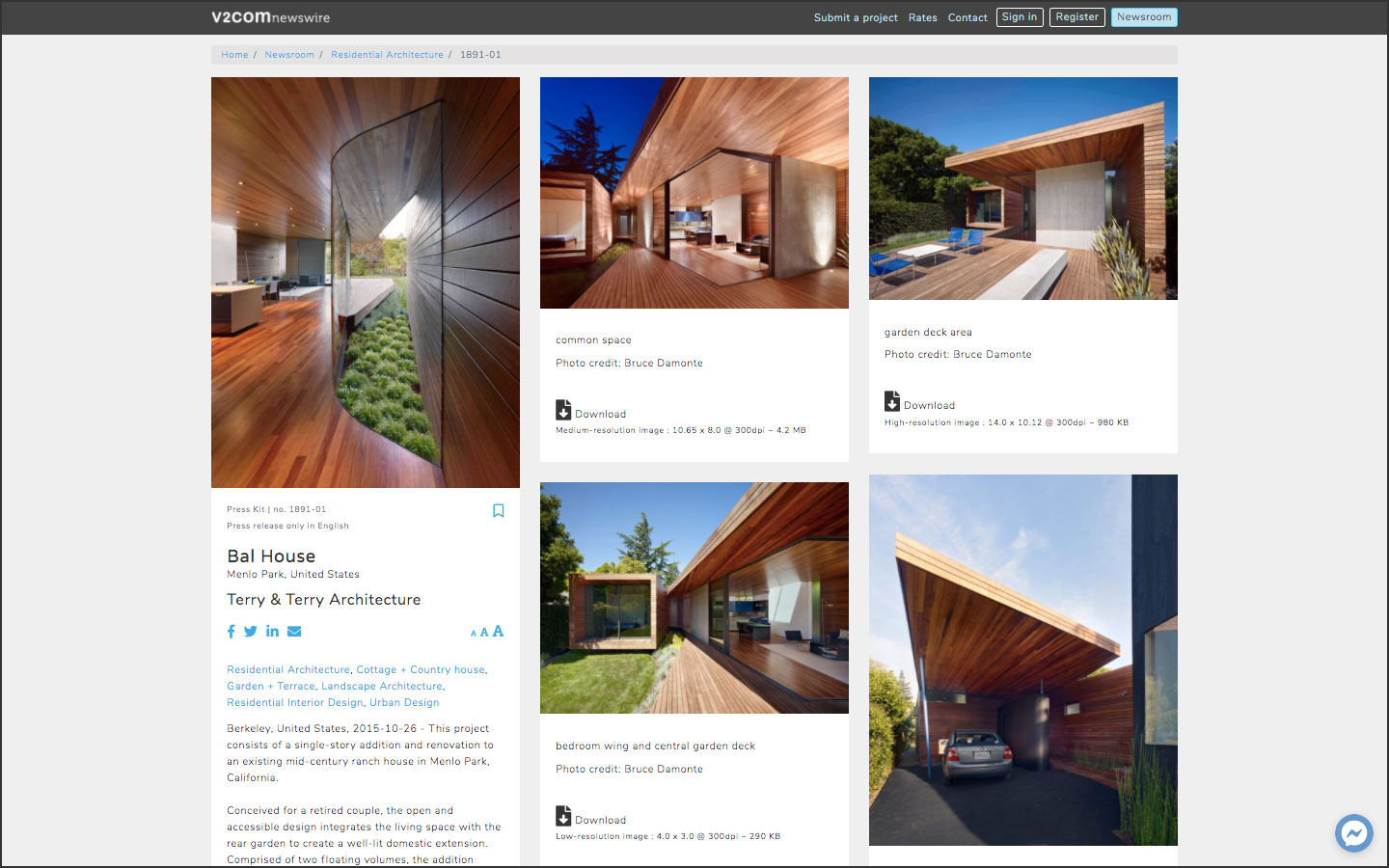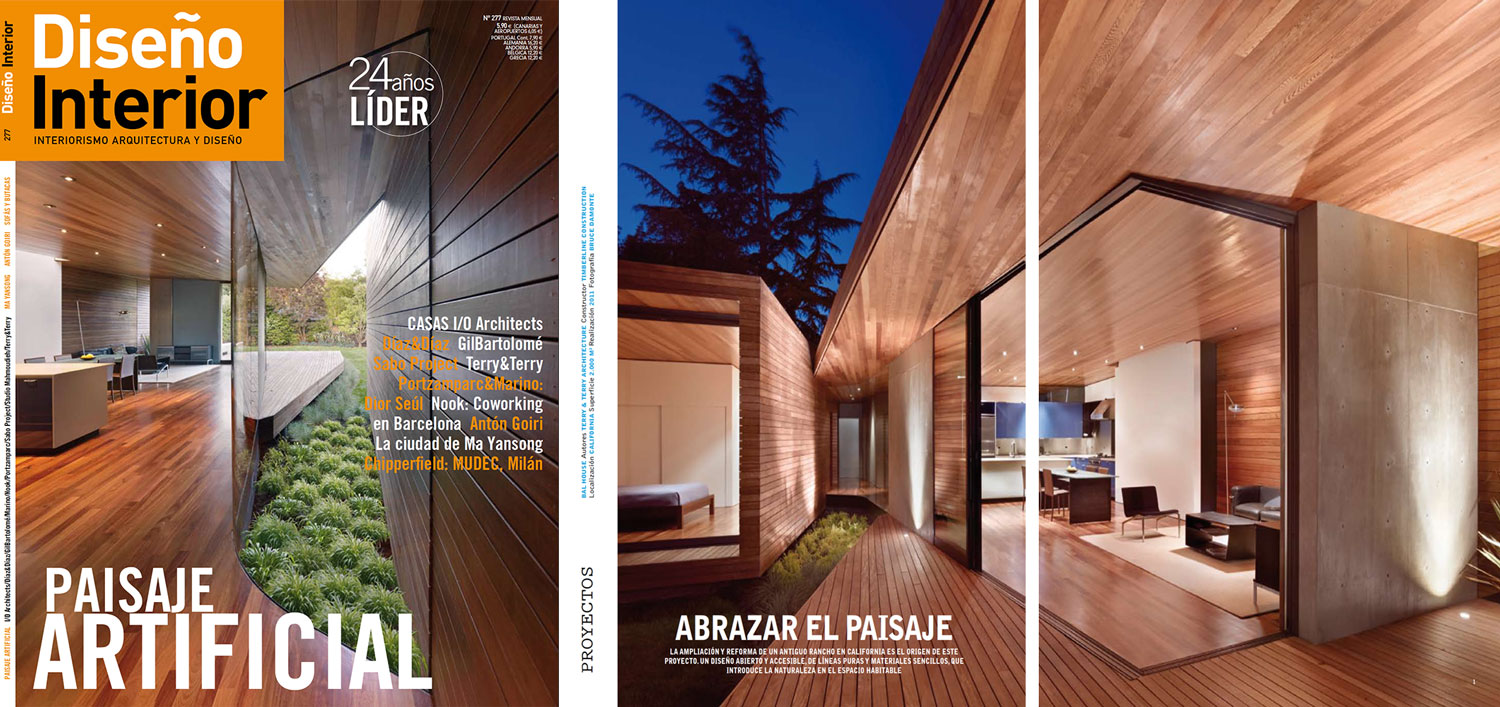
Essential media success factors for your architecture project
Case study: Bal House by Terry & Terry Architecture
Media coverage for a residential project
As experts with more than 25 years of experience in media strategy for designers and architects, we field a wide range of questions about media, how the v2com newswire works, and media relations. And one of the most common questions is also the hardest one to answer: who will publish my project?
Obviously, we don’t have a crystal ball to help us predict which media will publish any given project. The media’s needs, criteria, constraints and tastes are infinite, and they’re usually less predictable than you’d think.
So how do we gauge the potential media impact of a project? How do you know if your project will be published a little, a lot, enthusiastically or widely? Are there success factors for media coverage? Even though it’s impossible to predict or guarantee the results, there are indeed essential factors for media success for design and architecture projects. Yes, it is possible to optimize your impact by following a few rules.
We’ll look at those factors through a case study: the Bal House by Terry & Terry Architecture, distributed on v2com. We’ll see how certain key aspects of a project and its press kit can affect results.
...
The project

Bal House by Terry & Terry Architecture
Contemporary architecture (interior and exterior)
Residential project – single-family home
Expansion and renovation of a ranch house in California
The press kit
Press release in English
12 photographs, medium and high resolution
2 plans/technical drawings
Detailed technical sheet
Short description of the firm
Completion date: 2011
No embargo or other restrictions
Distribution
Release via the v2com newswire
No media relations
Release date: October 27, 2015
Sent to 2,595 specialized design, architecture and lifestyle media outlets
83 countries
5 categories
Results
1,594 media saw the project
7,895 page impressions
2,701 clicks
67 downloads
20 confirmed articles
4 print publications
16 online publications
1 magazine cover
Let’s take a closer look at the Bal House project and its press kit, to understand how it met the various media success factors.
The factors
Type of news
There are several types of news, and a project’s press kit can span multiple types and themes. A residential architecture project usually attracts more media coverage than an institutional project. Because there are multiple factors to consider, it doesn’t always work out that way. But statistically, there are many more publications specializing in residential design, because there’s a bigger target audience. The net result is higher chances of getting coverage.
Originality of the news item
Hundreds of new apartments, houses and dwellings are announced to the media each day – there’s a constant barrage of new projects, of every description. How do you make yours stand out? The media are looking for that special something, the “wow” factor that will make them decide to publish. So you have to highlight your project’s most distinctive feature.
For the Bal House, that element was the curved wall that draws the garden inside. It appears in the vast majority of articles about the house; it’s the touch that inspires people, and it’s usually the featured image. It even made the cover of a magazine! That’s also why this particular photo is on the cover of the press kit. It’s an immediate eye-grabber for the media. In a nutshell, you have to identify the one key detail that can make you stand out from the crowd, and put it front and centre in your copy and photos.
Exclusivity and relevance of the news item
Here’s the catch: the project was finished in 2011, and the release happened in 2015 – a four-year gap. A project should always be as recent as possible; typically, the media focus on projects from six months to at most two years old. Ideally, you’ll tell the media about your project a few months before it’s complete, or open if it’s a public building. But some media make exceptions and will publish regardless of the project’s age – as long as the project is still interesting and relevant to readers.
What’s more, the project had already appeared in some publications, but wasn’t widely seen. That’s why it was still appropriate to share it with other media. As far as possible, it’s essential to put fresh, exclusive news out there. It can dramatically increase your coverage.
Quality of the press materials
Terry & Terry’s press kit is a comprehensive, high-quality document. The press release is simple, effective and relevant. The copy is well-written, making it easy for editors to use. The higher a press release’s editorial quality, the easier you’re making it for editors, and that increases your chances of getting published. The press kit also includes a detailed technical sheet – a particularly popular feature with specialized media – and a short description of the firm. Beyond the project itself, media outlets like to know more about the designer or architect, the firm’s philosophy, a studio’s creative process.
The high-resolution photos are excellent, having been taken by a well-known professional photographer (@Brucedamonte). The architects also included plans and technical drawings. All of these elements are crucial factors for creating a strong media impact. Image quality is probably one of the most important success factors of all.
No doubt, your smartphone makes a great camera for your social media needs, and architects often have a good eye for composing a photo. But architectural editors have extremely high standards for image quality, and they strongly prefer professional photographs. They have their publication’s reputation to safeguard, and they want to deliver a high-quality article to their well-informed readers. The same goes for copy. A journalist will appreciate a press release written by a professional. Just as in architecture, there’s an expert for every specialty.
Number of images
It bears repeating: in design and architecture, images are crucially important. And that’s why v2com was launched 12 years ago – to deliver high-resolution images that would be adapted to our industry, easy to access and provide a comprehensive overview of a project. In addition to quality, quantity also affects your media impact. We see a clear pattern when comparing the impact of image-light and image-heavy press kits. Those with more than 15 images get more coverage. Those with more than 30 – and sometimes as many as 60 (photos and plans) – often see considerably more downloads and therefore media interest.
It’s simple. More images equal more possibilities for the publication. By being able to select images themselves, editors have the advantage of being able to publish an article that’s clearly different from others based on the same project. Lastly, the most important reason to offer dozens of images is that you help print publications write thorough, multi-page articles. In other words, press kits with more images often generate more in-depth articles.
In the case of the Bal House, the press kit included 12 images. That’s slightly less than the recommended minimum of 15 to 20. But that didn’t stop a large number of outlets from publishing articles, some of them several pages long. That’s why we stress the importance of all the factors combined, not just a single factor.
Media relations
Doing media relations using a media strategy and personalized follow-ups can undoubtedly be a success factor. Whether your in-house communications team handles media relations or whether you hire a specialized firm like v2com, it is often a good idea to send your project to several targeted editors, offering exclusive interviews and publication windows. We will explore the subject of media relations in more depth in a future article.
In the case of Terry & Terry Architecture, the project was released on the v2com newswire without media relations services, but with media monitoring to retrieve the articles.
Analysis

The average number of downloads for a residential project on v2com is 30 to 40. The Bal House press kit was downloaded 67 times – an excellent ratio. There were four printed articles and 16 online pieces. That’s also a very good ratio, since online publications publish more projects than printed magazines. An online outlet might publish 3 to 4 articles every day, for a total of around 1300 projects covered each year. On the other hand, a printed magazine will cover about 10 projects per issue, and typically publish six issues a year, for a total of 60 projects. That means there’s around 20 times as much digital as paper content out there.
For the Bal House there were 20 articles in all, both printed and online. What happened to the other 40-plus downloads? A few things. Some media probably published, but the articles could not be retrieved. Others downloaded the material for evaluation, with the intention of publishing an article later, but ultimately decided not to publish for one reason or another. One of those reasons, especially in the case of Bal House, is the age of the project. Some media were interested but backed off because of that. That was the case for Design Milk and Dwell, two very important publications in our industry, which downloaded the press kit but didn’t publish articles. But the architects were very pleased when both of them published the firm’s next project, released on v2com a few months later: the Skyline House.
This is a good illustration of why it’s important to give the media recent projects, and also to maintain a regular media presence. It pays to put yourself out there repeatedly. Just because they didn’t publish one of your projects, doesn’t mean they won’t cover the next one.
Another interesting detail: a press kit has an ongoing presence on v2com, without an expiry date. It can still be downloaded and lead to articles even five years later, as proven by this recent piece in Urbana magazine.
To recap: the decisive factors that increase media interest and optimize your coverage are a good press release, plenty of high-quality professional images, plans and technical details, a recent and unpublished project, an uncommon project or detail and, of course, a strong distribution network via newswire and/or specialized media relations. After that, it’s all about the feeling and the timing.
May the articles flow!
By Pénélope Fortin
A design graduate with a passion for communications, Pénélope Fortin has been in charge of media relations for designers and architects at v2com for more than seven years. A creative, detail-oriented professional, she is in contact with media around the world and loves developing innovative media strategies for her clients.

